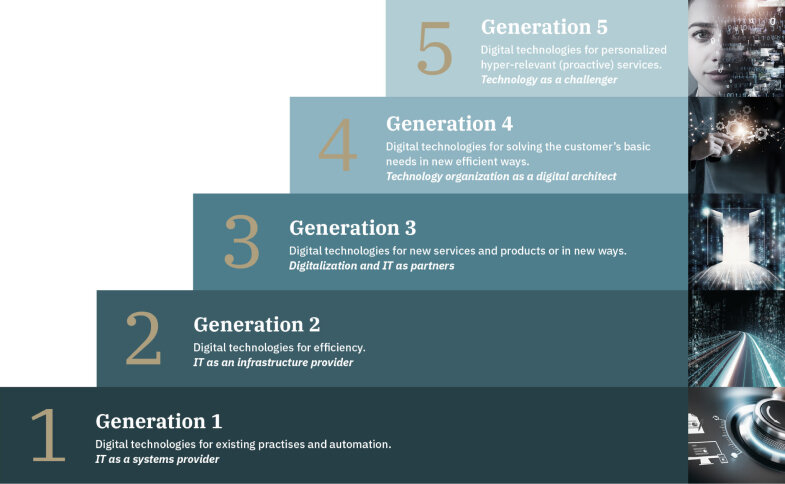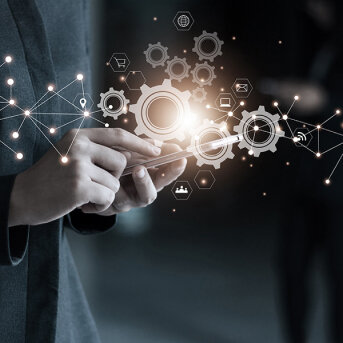The 5 Generations of Digital Maturity are based on Pernille Kræmmergaard's research over the past more than 20 years and our practical experiences from companies and organizations. The framework has evolved from originally containing 2 Generations. With the digital and technological development, Generation 3 was developed in the late 2000s, the 4th Generation in 2016, and Generation 5 in 2019. The contours of Generation 6 are gradually taking form. However, the technology that defines the 6th Generation is not mature enough yet that we find it relevant to build it.
The figure below shows The 5 Generations of Digital Maturity. At the bottom step, which is Generation 1, it is mostly about switch on workflows and processes. At the preliminary top step, Generation 5, the organization, and the company can, with the greatest obviousness, use the digital opportunities to become better at providing services and products to customers and citizens, and preferably before they even know what they are missing and as a motive for sustainable growth and development.
As you read about the generations, it is important to remember that they exist in parallel.

This might sound simple, but you will only succeed if you have an overview of your current state of digital maturity as well as clear strategic ambitions and goals. This framework for Digital Maturity supports that effort.
We recommend using our Online Tool to measure your current state of digital maturity and to continually track your progress.
The generations in the figure are depicted as a staircase because it is partly difficult to skip steps, and an organization will typically be on several steps, if not all, at the same time. An organization that has taken the trip all the way to Generation 5 and has the organizational skills that this preliminary top step requires - very few have - will still need the skills and part of the thinking and leadership practices that lie in Generation 1, 2, 3, and 4. But the digital mindset will be different.
Digital mindset is the understanding of how digital and technological opportunities change and at the same time can be used to improve competitive position and strategies, as well as the way the job is performed. Then the company will always be perceived as attractive and able to live up to the customer's, the employee's, and the stakeholders' changing demands and expectations.
Each of the generations represents an independent management practice and digital mindset, and each of them places different demands on leadership.
You can use the Digital Maturity Tool to uncover the 5 generations of digital maturity in your organisation.
If you are curious about whether our Tools are right for you and your organisation, you can order a free access and try the Tool.
In the first generation of digitalization, the focus is on supporting the existing business and services with digital solutions. This is especially the case in private companies who focus on devising digital solutions where customers can shop and serve themselves online or find information about products and services.
The digital strategic ambition here is to develop strategies for which channels the organization will use for the interaction with customers and citizens, as well as what information should be available digitally on the company’s website.
The mindset in Generation 1 is first and foremost to see IT as a system supplier and a supplier of savings. IT replaces manual work that was performed by employees, and an IT system is seen as a success if it operates stably without significant crashes and if its end-users are satisfied. In many cases, the company and the organization do not have integrated IT systems — instead, departments and business units have purchased what suits them and enhances their customers’ ability to do self-service.

If digitalization is to generate greater benefits, it is not enough to enable customer-oriented activities. The focus must now be on the internal processes and on the connections between the customer- and citizen-oriented digital solutions (front-end) and the internal processes (back-end). IT and digital initiatives must make the internal processes more efficient. Now there are ‘lean’ consultants working with virtually every company, and there are countless projects about analyzing and optimizing workflows and processes.
It is becoming clear that the systems need to be able to communicate with each other to a greater extent. The tailor-made local systems are being, or will be, replaced by standardized systems. It’s not just a matter of buying standard systems; there is also a demand for greater uniformity across the organization so that the systems can communicate with each other. This means that processes and workflows must be adapted to systems rather than vice versa. Sometimes this will involve functional impairments for some users and more cumbersome workflows compared to previous ways of doing the job. On the other hand, this can help to streamline internal procedures and enable better coordination and coherence.
Central digital strategies are being developed, focusing in particular on making administrative processes and centrally-anchored projects more efficient. And leadership is focused on encouraging efficiency and getting IT systems implemented.
The whole thing is often project-oriented with supervisory and follow-up groups and frequent reviews. And the IT and / or digital department—such a department will typically be created or will achieve greater influence and significance—will be regarded as a provider of infrastructure and efficiency improvements.

As the processes mature and the understanding of digital technologies grows, the focus and content related to digitalization begin to change and become more pervasive. It is the step from Generation 2 to 3 that is the most difficult because in Generation 3 the old mindset no longer works if one is serious about taking advantage of the new opportunities.
In Generation 3, companies will feel that they are under pressure from new players who are changing the market and forcing them to innovate their solutions and products, and they will start to involve customers more in the development process to ensure that the customer’s demands and expectations are met. Standard products are no longer enough, and companies will need new capabilities to create value and revenue across departments and business units in an interplay with customers and other partners. Here the technologies can also play a creative role.
In this generation, the digital element becomes part of the service or product itself. It’s about how we can leverage technology to rethink our core products or services and the way we produce or execute them. This requires a curious and open approach to digital technologies and how they can be used to deliver services in new ways that better meet customer expectations and requirements.
It requires increased interaction with the customer, and experiments where things are tested with the customer - and quickly, so it soon becomes clear whether the experiment is headed in the right direction. The organization must recognize that discarded experiments are not failures, but the result of a necessary process of trying until you get it right. It requires the ability to identify success and quickly scale it up from pilot to full scale.
The gut feeling becomes important — in this generation, not everything can be mapped out in careful business cases. The decisions weigh heavily on the ability of digital technologies to deliver services in new ways for the benefit of the customer, but also for the company or organization, either in the form of savings or new revenue... or both.
The customer and the citizen are more at the center than in Generations 1 and 2. Their wishes must be met, often in new ways, and they will be active co-creators of the solutions and services. In this generation, leaders must bring IT and digital competencies closer, because close collaboration with IT- and digital-savvy people is necessary if the potential of digital technologies is to be exploited.

Many organizations are working to build the competencies that Generation 3 requires, but some are moving past that. They do not only ask how the technology can be used to provide customers and citizens with new products and services in new ways — but they are also beginning to see that digitalization offers opportunities to change the core products and business model significantly. And they see that as the key to improving their competitive position in a constantly changing landscape.
In Generation 4, the mindset is focused on constantly looking for new ways to meet the basic needs of the customer and the citizen, even in ways that have not been seen as part of the company’s core activities previously. The company and the organization become proficient at constantly challenging themselves to understand what the customer’s needs really are and whether the old assumptions about the customer and the business model still hold.
Intuition, courage, and experimentation are still crucial elements, but, at this point, coherence, integration and collaboration with others begin to appear as an opportunity to create new business models or solutions.
If the customer is to experience the seamless and coherent service that is the intention, it often requires close cooperation with other organizations and their services, systems and/or data. The company and the organization must be able to connect with others in a network where you create and share value — in an ecosystem, so to speak, where you are interconnected.
A key question for leaders becomes: Who and what should I connect with whom and what to create new services that best meet the customer’s needs? What data, IT systems, and technologies should I use and how should I use them?
In Generation 4, strategic digital work is closely linked to the rest of the company’s strategy; it is not something that is loosely linked to it or has a separate agenda. It is fully integrated. The digital element becomes so much a part of the whole business mindset that it cannot be seen as an independent entity.

“A complex web of interdependent enterprises and relationships directed towards the creation and allocation of business value.
[...] Ecosystems will typically cut across multiple organizations, functions and industries, providing a foundation for new, seamless consumer experiences and the masking of functional complexity.”
Berman and Marshall, 2014
In Generation 5, several technological opportunities such as artificial intelligence (AI) and machine learning allows the organization to seek and create new patterns and opportunities and to use them in combination with human judgment to direct personal and relevant offers and services to the individual customer — and only to the one for whom it is relevant. This is a pivotal break with standard products and services. A decisive difference is that the relevant products and services can also be offered proactively before the citizen or customer has even asked for them.
That is why transparency and clarity for the citizen and the customer are crucial in Generation 5. The ethical issues regarding data usage must be taken seriously. Citizens and customers must have insight into what their data is being used for, and the criteria for data use must be transparent. Citizens and customers should also be able to refuse permission for usage of their data unless the use is mandated by an actual official requirement where a government institution is required to have access to specific information. If transparency and the ethical parameters are clearly defined, the combination of technologies and human judgment can help citizens and customers by creating greater clarity and relevance in the offers they receive.
It also creates new requirements for professional competency and job specifications. Many will find that their jobs are changing as technology provides new ways to best meet the needs of customers and citizens. Leaders will face new demands to ensure that there is room to develop and use new skills.
With Generation 5, we are creating areas of relevant possibilities for citizens and customers, sometimes proactively. When they receive offers, using self-services, or are in direct contact with staff, they must be provided with the information and the options that are right for them. They should not be forced to navigate a bewildering amount of unnecessary information.
In the same way, technology should be used to create clear areas of possibilities for employees, so that they do not have to use their work energy on anything other than what is relevant for the situation and what is perceived as meaningful. Transparency, clarity, and a high ethical standard are key words if the possibilities of Generation 5 are to be used to their best advantage.
Ethics are also crucial for the company’s stakeholders and society in general. There are increasing expectations that companies and organizations not only solve tasks for customers but generally contribute to a better and more sustainable world, as defined, for example, by the UN’s Sustainable Development Goals.

In Generation 5, collaboration in the ecosystem will be further expanded, and digital technologies will become a driving force when it comes to finding the relevant partners. At the same time, the organization will be focused on assessing new technological opportunities and begin using them if they enable the organisation to better do the jobs for customers.
What you have just seen is a brief introduction to the 5 Generations of Digital Maturity, based on Pernille Kræmmergaard's more than 25 years of international academic research, as well as practical experience from hundreds of courses and workshops with private companies and public organizations.
The framework is described more in depth in the book "Digital Maturity - Strategy, Technology, Organization and Leadership in 5 Generations".
The book is intended as a user manual for managers at all levels.
Buy the book directly from the publisher
You might also benefit from our Online Tools to measure your current state of digital maturity and to continually track your progress.

Watch the video for an introduction to the Digital Maturity framework or read the short paper that introduces the 5 Generations of digital maturity. This is particularly relevant before mapping the Digital Maturity.